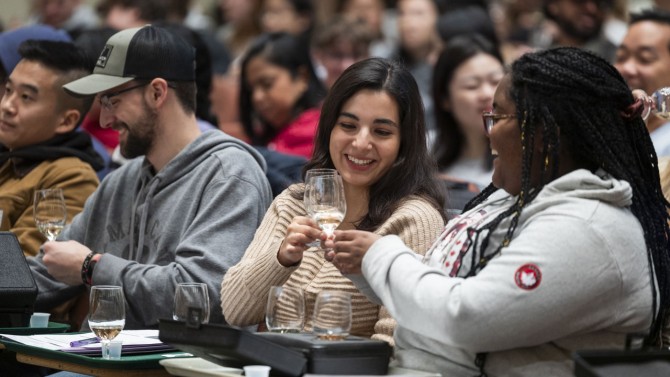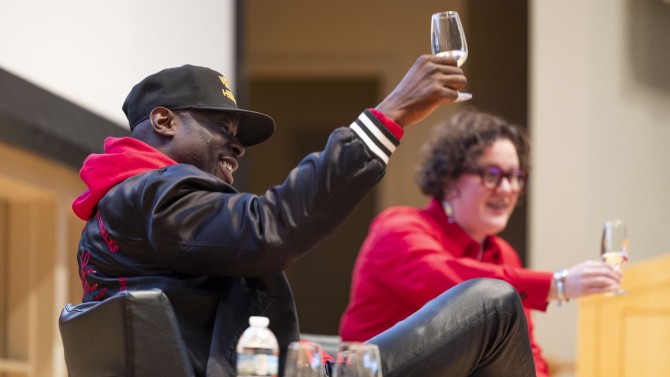
Students attend “HADM 4300: Introduction to Wines,” one of Cornell’s most popular elective courses.
Iconic wines class gets better with age
By David Nutt, Cornell Chronicle
Mountaineers have Mount Everest. Musical prodigies have Carnegie Hall.
Cornell has the wines class.
One of the university’s most popular elective courses, not to mention the envy of college undergraduates everywhere, the iconic “HADM 4300: Introduction to Wines” has helped generations of Cornellians refine their palates – and knowledge – about the many varieties of wine and how each is produced, bottled, labeled, distributed, sold and, ultimately, savored.
Cornell’s first wines course – and the first accredited wines course offered at any American university – launched in 1953 for students in what is now the Cornell Peter and Stephanie Nolan School of Hotel Administration. This semester the course is celebrating its 50th anniversary as an elective open to students of all majors.
Few traditions in college lore can match the class in which students are served quality alcoholic beverages every week. And, just like a fine cabernet sauvignon, Intro to Wines has only deepened with age.
“It is a journey. We teach the basics of what is wine, and we travel each week to a different place in the world to learn about wines,” said Cheryl Stanley ’00, a senior lecturer in food and beverage management at the Nolan School who has taught the class for the last decade. “That sense of place is not just wine, it’s the people. It’s the history of the region. The wine world changes every year. Mother Nature gives us something different. … And you can relate wine to anything that we study here at Cornell.”
Understanding wine is not just a treat for taste buds and palates. It is crucial for anyone pursuing a career in the hospitality industry, or any business for that matter.
“Wine is a very scary field to look at because you have the viniculture side, the agriculture, the farming part, then you have the knowledge that accompanies knowing how to sit and discuss wine,” said Delesa McCruter ’25, who took the course last spring. “Because being a hotelier, a lot of the deals I will probably make in my life will be somewhere at some lounge, some bar over a glass of wine.”
The original Introduction to Wine and Spirits was launched in 1953 by a group of five New York vintners and importers, one of whom, Julius Wile, was the course’s first instructor and famously commuted up to Ithaca from New York City once a week for 30 years. However, the course as it is known today was first taught by the late Vance Christian, the Villa Banfi Professor of Hotel Administration and Cornell’s first Black tenured faculty member. During his 23 years of teaching, Christian modernized the Hotel School’s food and beverage curriculum, and he popped the cork on the wines class, making it available to everyone.
“Professor Christian had a vision of saying it should not just be for the hotelies to learn about wine and to be able to have a seat at the table. It should be for every single individual here at Cornell University. And it goes back to Ezra Cornell’s mission of any person … any study,” Stanley said. “So everyone has equal access and opportunity to learn about the world of wine.”
One thing that hasn’t changed over the last 50, or 75, years: Competition for a seat in the class is fierce. There were 106 juniors and seniors enrolled in the first class in 1953. The current semester enrollment is about 700 students. The wait list for HADM 4300 is almost as legendary as the class itself.
‘This class is a beast’
If taking Intro to Wines is a coveted Cornell tradition, so is teaching it. Since Christian revamped the course 50 years ago, only two other instructors have led it. When Christian was diagnosed with cancer, he passed the baton – or, rather, the bâtonnage – to his former teaching assistant Stephen Mutkoski ’67, Ph.D. ’76 in 1983. Christian died a year later, and Mutkoski taught the class for the next 30 years, shaping it into a more consumer-oriented course. During his tenure, he also eliminated spirits from the curriculum.
Stanley was hired to teach the class in 2013. She hardly needed any introduction to Intro to Wines. She had taken it in her junior year in the fall of 1998 and, like Mutkoski, she had been one of its teaching assistants. (“Steve TA’d for Vance, I TA’d for Steve, so we kept it in the family,” she noted.) As a student, she was interested in food and beverages and wanted to pursue a career in restaurants, but she was still undecided about the specifics.
“Watching Professor Mutkoski on stage showing these pictures and talking about the history and the culture, I was like, oh my gosh, I have found my subject,” she said.
Teaching such a beloved class is not without its challenges. There are at least 700 of them.
“You know, teaching in front of 700 people is not something that, for some, is easy upfront,” Stanley said. “Steve said, ‘listen, this class is a beast. Every semester is different. And every semester, you’re going to be tasting new wines, and you’re going to be dealing with different students. So I want you to be comfortable with the class.’”
She and Mutkoski co-taught the class together for a year before she took it over solo in 2014 and Mutkoski retired from Cornell.
“He also understood that it’s an institution,” she said. “He traveled the world for years, going to events, because he also was an alum of the Hotel School. People would come up to him in the airport and say, ‘You were the wines professor, I took your class at Cornell.’”
‘Cultural capital’
Wines class students are easy to spot. The course fee includes a $45 wine-tasting kit comprised of three glasses inside a black, foam-lined case.
“If you’re on campus on a Wednesday, it looks like we have a lot of clarinet players,” Stanley said.
For anyone wondering how much wine is required for 700 students, here is a little math: Of the course’s 14 classes each semester, 12 feature tastings for up to seven different wines. Each student is served one ounce of each wine, and a typical bottle of wine contains 25.4 ounces. That works out to roughly 210 bottles a class, or 2,520 bottles for the semester.
“We are very lucky to have alumni in the wine industry who generously support the class and partners in producers,” Stanley said. “Companies see the benefit of being poured in a 700-person class. I mean, these students are going to become brand ambassadors for these wines.”
Chayil Hyland ’25, a former wines class teaching assistant who is now taking the class as a student, says learning how to read a wine list and evaluate a wine’s characteristics and knowing what foods it can be paired with, all help increase a person’s “cultural capital.” She also learned something new about herself: She has a fondness for Rieslings.
“It’s very exciting when we get the wines and we get to try it. But it’s also important for everyone to pay attention,” Hyland said. “Not only are we tasting the wine, we’re learning about the history, we’re learning about how to read the wine labels. And, of course, those are all the things that are on the exam. … It’s a really robust class. And although it’s difficult to get into, once you get in, you’re happy that you’re there. You’ll take something from that class that you’ll use for the rest of your life.”
Of course, drinking wine is not a prerequisite for the course. Plenty of students use spit cups after they sample the beverages or don’t imbibe at all. During the pandemic, when the class was conducted online, Stanley sent out scratch-and-sniff stickers so the students could still do their evaluations.
Big Red bubbles
For the last class of the semester, Stanley celebrated 50 years of Intro to Wines by linking it with another 50-year anniversary: the founding of hip-hop. She was joined by guest lecturer Jermaine Stone, host of the Wine and Hip-Hop podcast, the TV series Street Somm and owner of Cru Luv Selections.
The focus of the class was champagne and sparkling wine. While TAs in white lab coats went up and down the aisles, distributing the samples, Stone paired each wine with a kindred hip-hop song: Master P and Prosecco from La Marca, Nas and chardonnay-based sparkling wine from Dr. Konstantin Frank, Drake and Llopart's Corpinnat brut reserva rosé.
“I really like how Jermaine has made wine and hip-hop accessible to all,” Stanley said. “For me, my goal in life is to make wine accessible. You don’t have to make it this hoity-toity product that is very elitist. There is a wine for everyone out there.”
For the final drink of the class, everyone raised a glass of Banfi’s Rosa Regale – which Stanley calls “Big Red bubbles” – a tradition that caps every semester.
“To me, it’s more important that we toast with the Big Red bubbles than some crazy expensive wine,” she said. “I’m teaching people how to enjoy life. I mean, yes, it’s to become wine lovers and to be able to open your eyes to all that the world has to give. But I want it to be an inclusive environment. How can you create that inclusive environment for anyone to be able to learn the vocabulary of wine.”
Media Contact
Adam Allington
Get Cornell news delivered right to your inbox.
Subscribe


